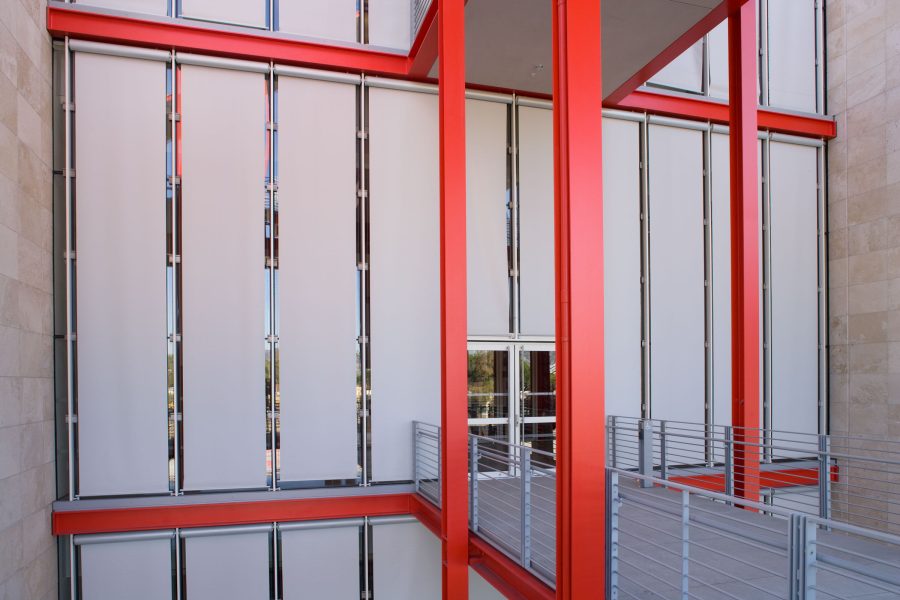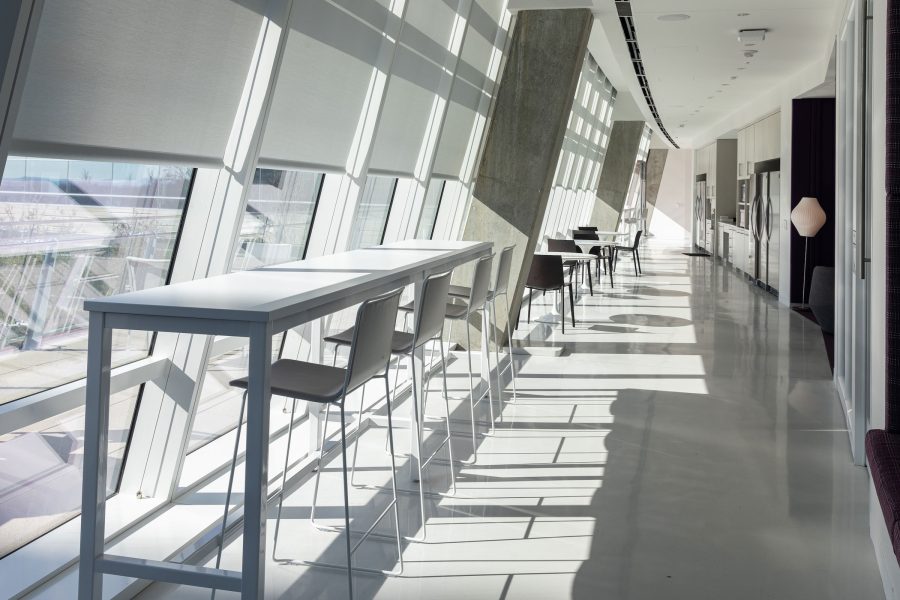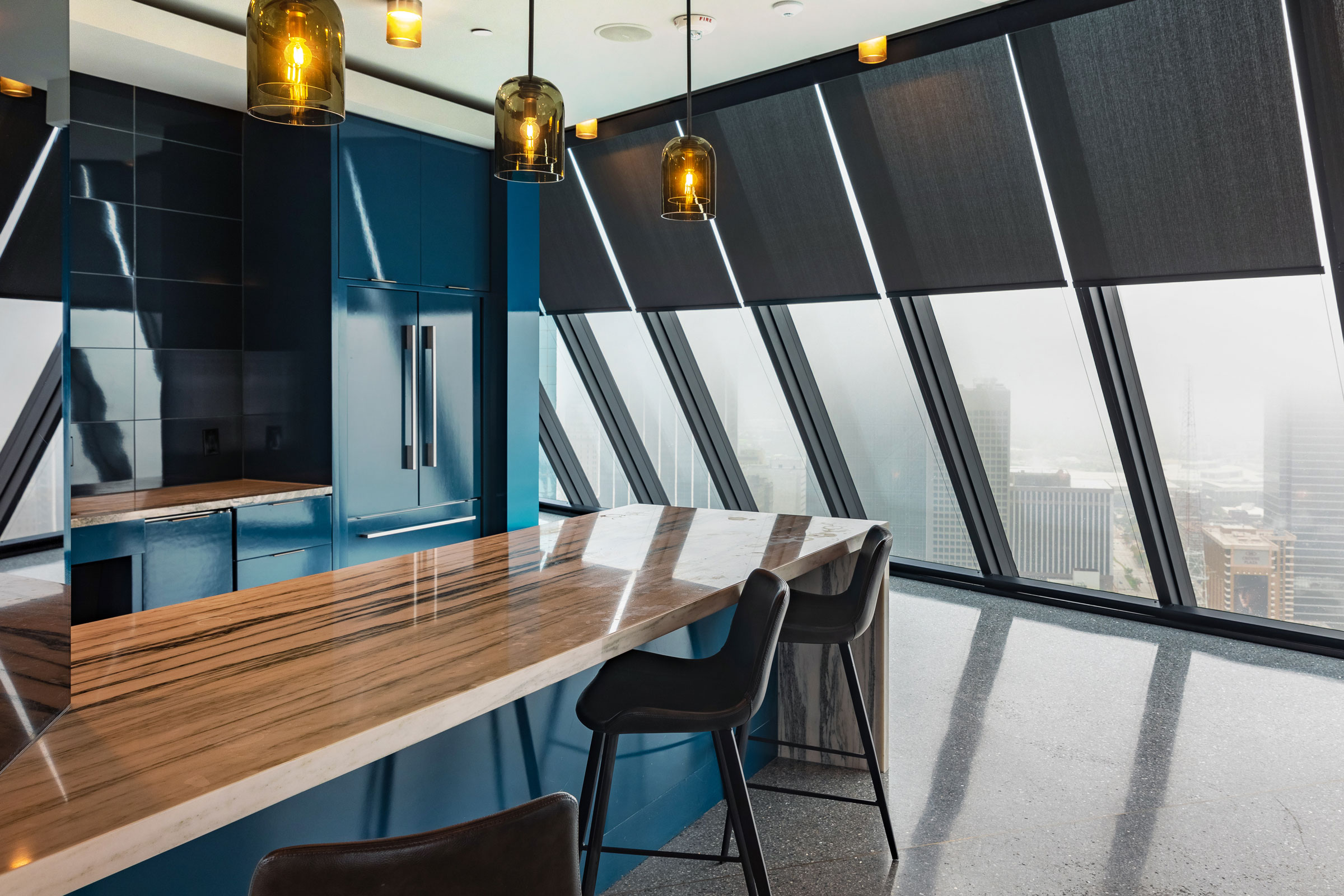Story at a glance:
- Controlling daylight, not just harvesting it, is crucial to modern building design.
- Location, orientation, aesthetics, and purpose are key considerations.
- The best manufacturers offer sustainable, automated, and customizable solutions.
You know it when you step into a room. You feel it—on your skin, behind your eyelids, in the deep rhythms of your unconscious. Lighting, especially daylight, is essential for creating a healthy, productive interior space.
Nick Inman, senior project manager at Hunter Douglas Architectural, an industry-defining manufacturer of window coverings and architectural products for more than a century, spends a lot of time thinking about this fact. Ask him for examples, and he’ll pull up photos like an 850-year-old, gold-splashed cathedral ceiling in Palermo, Sicily. “This is daylighting,” he says. “The reason they painted the whole upper half in gold—real gold—was because it was the most reflective material they had at the time.”
He’ll also mention the genius of industrial-era factory design, where north-facing clerestory windows and sawtooth roofs were no accident. They were designed to direct as much light as possible onto the factory floor.
Inman says these historical, cross-cultural truths often surface in his work today. Designers are relearning the art and technology of controlling daylight in our spaces—not only for its potential to save energy but also for its role in productivity, creativity, and health.
A New Day

Controlling light and glare is crucial in an art setting such as LACMA. Photo by Roland Bishop
A range of concerns comes into play when designing a customized daylighting plan for a modern building, Inman says. But no matter when a team like his joins the process—whether during the ideation stage, just before breaking ground, or long after the building has opened—they can find solutions that balance the power of the sun with human needs by asking a few key questions.
“Our first question is: What does the building look like? We examine the building plan, the orientation, and the location.” A project in northern Alberta, Canada won’t have the same challenges and opportunities as one in sunny California. In one case Inman may recommend directing light and heat onto a slab floor to reduce heating costs in winter, while in the other he’d likely explore how to reduce glare with exterior shades.
Purpose also matters: What is the space used for? Is it an art gallery or office space? Should daylight be minimized to protect sensitive objects, or leveraged to keep workers productive and comfortable even on the hottest, brightest days?
How can the space be made as sustainable and healthy as possible for the people who use, maintain, or are impacted by it? “In hospital settings, for example, facilities workers have much bigger concerns than maintaining the shades,” Inman says. Only by taking all these factors into account can designers and manufacturers create a customized system that stands the test of time.
Light and Shadow

The American Airlines headquarters in Fort Worth was designed to include sloped wire-guided shades from Hunter Douglas Architectural. Photo by Jim Hamel
For modern designers like Shivani Langer, director of regenerative design and senior project architect at Perkins&Will, creating healthy spaces is a calling. Twenty years ago conversations around daylight focused primarily on energy savings, with an emphasis on harvesting natural light to minimize artificial lighting. But that has evolved with the rise of LEDs and stricter building codes.
“Turning off the lights no longer saves as much electricity as it used to,” Langer says. Now the bigger question is how to control the light that enters a space to maximize comfort and usability—and how to do so sustainably, often to meet and exceed benchmarks like LEED or the WELL Building Standard.
“Early versions of LEED only asked us about how much daylight was getting into the space. That was a minimum standard,” she says. Today certifications require a balance between daylight and occupant comfort. “All rating systems are realizing it’s not enough to bring in minimum daylight; we also need to stop glare that leads to discomfort.”
To achieve this balance modern designers have an array of solutions at their disposal, including healthy window coverings made from PVC-free fabrics or recycled ocean plastic, and innovations like solar control fabrics that reflect solar energy, absorb minimal heat, and still allow in diffused light. Sustainability, both in materials and processes, is a growing focus for modern designers and their clients. Organizations like Hunter Douglas Architectural strive to meet high green building standards with many products, including venetian blinds made from recycled aluminum, being Cradle to Cradle–certified, and having both GREENGUARD and OEKO-TEX certifications.
Technologies like animeo and Solarai automate natural light management based on the sun’s position in the sky and facade orientation. Powered by partners Somfy and Embedia, the intelligent systems elevate these materials to a new level by intuiting a building’s daylighting needs, even when occupants aren’t present. However, Langer warns that choosing the right level of automation is critical in our AI-driven world. “Automation is great, but surveys show that people are less satisfied with their spaces if they don’t have control. It is good to provide automation with manual overrides.”
A New Slant

AMLI Fountain Place top-down and bottom-up tension shades. Photo by Jim Hamel
Controlling daylight will only become more nuanced as new challenges emerge. Privacy and security are becoming key concerns for designers, especially in educational settings, Langer says. Likewise, extreme weather and tighter building regulations will require new solutions. Designers and manufacturers must collaborate, using both advanced technologies and time-tested knowledge, to meet these hurdles.
Inman points to the east-facing windows in his Los Angeles office as a prime example—durable venetian blinds outside, soft natural twill shades inside. “One of the best fabrics we have for glare control, outward visibility, and occupant comfort is a twill weave. Twills have been around for thousands of years,” he says. “But if I only had that fabric roller shade, I’d need a very tight weave or the sun’s corona would burn a hole in the side of my head. It wouldn’t be great for working. Instead we have a more open weave to handle glare, and an exterior venetian blind to block the morning sunlight. Now it’s afternoon, and the sun is in the south. I have my shade down for glare control because there are shiny cars in the parking lot reflecting light, but I can still see. I’m interacting with nature. I can see people,” he says. “This isn’t a new concept, even in the simplest architecture.”

